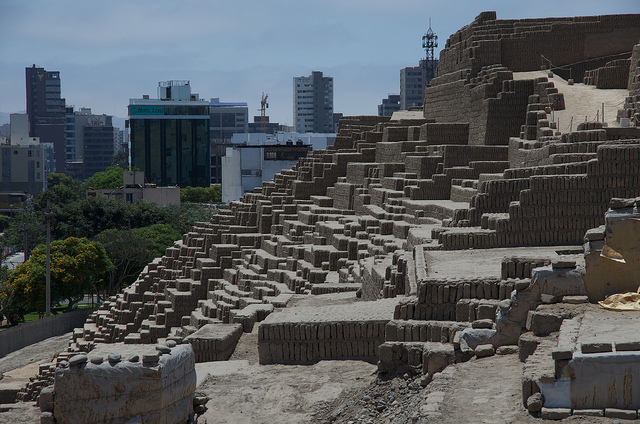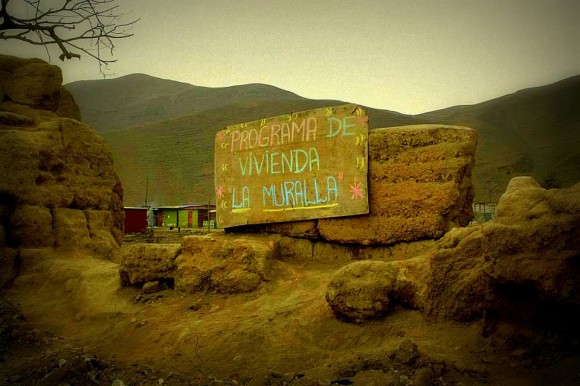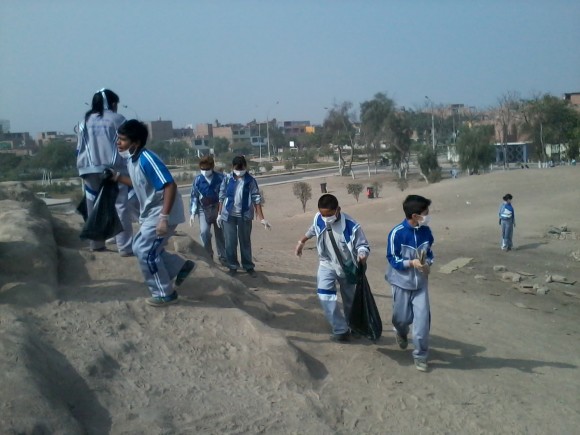
Huaca Pucllana, Lima. Photo by Flickr user Robert Nunn. Creative Commons Attribution-NonCommercial 2.0 Generic (CC BY-NC 2.0).
Have you ever related archeology with activism? Well, maybe you should start. In Peru, the land of millenary cultures, several groups are working to ensure that the nation's large archeological heritage is not lost and is part of Peruvian pride.
Save Las Huacas (SLH) is a project that can be traced back to 2001 when school teacher Koke Contreras, along with students from the Limean school where he worked, tried to create citizen networks for the archeological heritage's defense and preservation:
El proyecto aprovecha las nuevas tecnologías de la información y comunicación (TIC) como instrumento para la organización y movilización social orientada a la preservación del patrimonio cultural. SLH busca convertirse en un instrumento para diversas comunidades locales interesadas en desarrollar sistemas de vigilancia ciudadana y participación local en la defensa y preservación del patrimonio arqueológico.
The project takes advantage of the new information and communication technology (ICT) as a tool for social organization and mobilization geared towards the cultural heritage's preservation. SLH looks to become a tool for various local communities interested in developing citizen surveillance systems and local participation in the archeological heritage's defense and preservation.
What are las huacas? Historian Juan Luis Orrego Penagos explains:
Por definición, huaca es el término quechua que hace referencia a un lugar u objeto sagrado. Por lo tanto, huaca puede ser una construcción religiosa, un cerro, una laguna, un riachuelo, un árbol, una cueva o cualquier lugar u objeto (una piedra, un ídolo o una momia) que los antiguos peruanos consideraban sagrado. Con el tiempo, el término ha cambiado de connotación y hoy llamamos huaca a todo el patrimonio monumental y arquitectónico prehispánico como templos, centros administrativos, fortalezas, cementerios, etc. Es decir, los peruanos actuales asociamos el término con cualquier construcción física levantada por nuestros antepasados.
By definition, huaca is a Quechua term that refers to a sacred place or object. Therefore, huaca can be a religious structure, a hill, a lagoon, a stream, a tree, a cave or any place or object (a rock, an idol, or a mummy) that the ancient Peruvians considered to be sacred. With time, the term's connotation changed and today we use huaca for all monumental and pre-Hispanic architectural heritage such as temples, administrative centers, forts, cemeteries, etc. That's to say, we Peruvians actually associate the term with any elevated, physical construction made by our ancestors.

“Salvemos las Huacas” (Save the Huacas) page banner. Used with permission.
Save the Huacas has two goals: sketch maps of Lima's archeological remains through its web platform and create citizen awareness regarding the importance that these remains have for local and national identity. To do this, they hold activities such as archeological hikes “with the intention to identify what state our archeological heritage is in, to search for, register, and document its current condition, so that later maps of new sites can be sketched on the platform” that also serve to attract the interest of more citizens.
Some hikes are supported by archeologists, who explain to the assistants the history of the huaca and what is being done to recover, as these videos show.
In this video, the guide explains how the zone where the huaca is located used to be, and how nowadays the huaca and the guided visits have changed the perspective of the surrounding area:
In this second video, we see the guide explaining how the area was in pre-Hispanic times, how ancient Peruvians used the facilities and how the area is been preserved nowadays:
In a blog post on Save the Huacas, Koke Contreras reflects on what the participants saw on one of the hikes in Murallas de Chuquitanta, an archeological site in the Lima surrounding area:
Photo Enrique Mori. Used with permission.
Avanzamos a buscar las demás murallas hasta que ante nuestrosojos apareció una invitación a vivir en esta tranquila zona de Lima. En efecto el boom inmobiliario se hizo presente, no podía faltar. Una muralla de barro prehispánica a punto de colapsar nos daba la bienvenida. Un cartel nos invita a vivir en esta bucólica parte del valle. Aproveche la ocasión, separe con tiempo, marque su lote, coloque su piedra, su cerco e imagine la casa soñada ¿Podrá soportar esa muralla defensiva que repelió los ataques e invasiones de otras comarcas antes de la llegada de los Incas la invasión inmobiliaria?
We went on in search of the rest of the walls, until an invitation to live in this tranquil zone of Lima appeared before our eyes. In effect, the real-estate boom happened, it couldn't be missed. A pre-Hispanic mud wall on the verge of collapse welcomed us. A sign invites us to live in this pastoral part of the valley. Take advantage of the occasion, separate with time, choose your spot, place your rock, your fence, and imagine the dream home. Will that defense wall, which once repelled the attacks and invasions of other regions before the Incas’ arrival, be able to withstand the real-estate invasion?
Along the same lines, the Colectivo Colli develops activities that promote local identity through the knowledge and assessment of history, especially in the Lima district of Comas, northern Lima, and surrounding areas:
El Colectivo Colli es una organización conformada por niños, niñas, púberes, adolescentes, jóvenes y personas interesadas en la protección del patrimonio arqueológico, cuyo principal objetivo es la sensibilización para la defensa y conservación de los diferentes monumentos, construcciones, caminos, murallas y expresiones materiales de los antiguos pobladores prehipanicos de la zona de Lima Norte.
The Colectivo Colli is an organization composed of young people, teenagers, young adults, and individuals interested in the archeological heritage's protection. Its main objective is to increase awareness in the defense and conservation of the different monuments, buildings, roads, walls, and tangible expressions of the ancient pre-Hispanic settlers from northern Lima.
One of Colectivo Colli‘s activities is to clean the huacas, carried out with specialized, technical support and collaboration from schools in the area.
Students from Colegio William Shakespeare cleaning the Huaca El Retablo.
En la Huaca El Retablo se estuvo coordinando a lo largo de la semana con entusiastas vecinos cercanos al sitio arqueológico, ellos vienen haciendo los esfuerzos por rescatar del estado en abandono en que se encuentra este espacio, que en horas de la noche es frecuentado por personas de mal vivir. A ellos se sumaron entusiastas estudiantes de secundaria del Colegio William Shakespeare quienes guiados por sus maestros realizaron la limpieza de la huaca y sus alrededores.
At the Huaca El Retablo [The Alterpiece Huaca], Colectivo Colli coordinated with enthusiastic neighbors nearby the archeological site throughout the week. They come and make a big effort to salvage the abandoned state this space finds itself in, which is frequented at night by unsavory characters. Led by their teachers, enthusiastic students from the Colegio William Shakespeare joined up to clean the huaca and its surroundings.
Futhermore, the Protective Cycling Circle for Las Huacas also contributes to the preservation of material and immaterial heritage. In addition, it promotes the bicycle as a means of transport via cycling trips or archeological bike rides:
La actividad se compone de una visita guiada al mes por las diferentes Huacas de los distritos de Lima, donde se explica el papel que cumplían en su contexto histórico, se evalúa su estado de conservación y finalmente pedalean en círculos a su alrededor para reconectarse con ella y revitalizar su energía protectora.
The activity is composed of a one guided visit per month through the different Huacas in Lima's districts. It explains the role they fulfilled in their historical context and evaluates their conservation status. Finally, the cyclists pedal in circles around the Huacas as a means to reconnect with them and revitalize their protective energy.
These and other projects such as Cuida tu Huaca PLO (Take care of your Huaca PLO), Instituto de Cultura, Historia y Medio Ambiente – ICHMA (Culture, History, and Environment Institute), HistoriActual, Fortaleza de Campoy (Campoy Fort) and several more, make up a network of scholars, activists, and people of all ages that promote assessment and awareness regarding the need to conserve the nation's archeological heritage.
At a time when Peru's heritage has been threatened and a large portion of the population lacks of awareness, support from institutions, local government, and the state is needed — as well as the participation of everyone in general.









3 comments